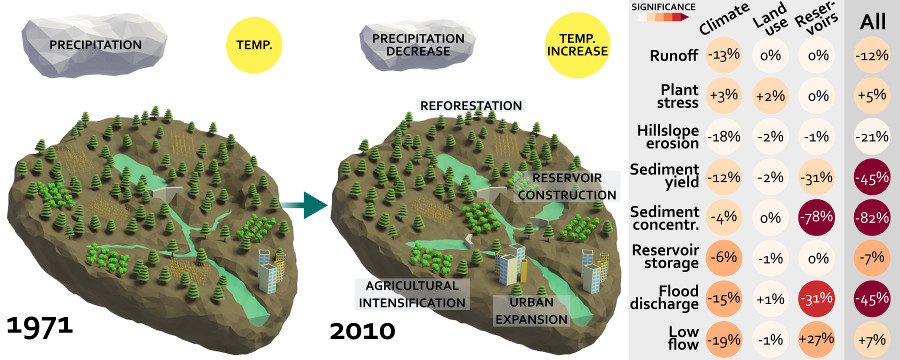
The Mediterranean region has been identified as one of the most affected global hot-spots for climate change, which is already manifested by faster increasing temperatures than the global mean and significant decreases in annual precipitation. Besides, over the past decades, important land cover changes have occurred, such as reforestation, agricultural intensification, urban expansion and the construction of many reservoirs. Here we study the impacts of these changes in a typical large Mediterranean catchment and focus on relevant ecosystem services, i.e. primary production, water supply, food production, water regulation, flood and erosion control, and cultural ecosystem services. We applied a hydrological model, coupled with a soil erosion and sediment transport model, for the period 1971-2010 to the entire catchment, and for an extended period (1952-2018), with more pronounced land use changes, to one of its subcatchments that plays a crucial role for regional drinking water provision. Climate change in the evaluated period is characterized by a decrease in precipitation and an increase in temperature. Land use changes included an increase in natural vegetation in the headwaters, agricultural intensification and reservoir construction in the central part, and urban expansion in the downstream part of the catchment. The positive impacts on ecosystem services were quantified by a decrease in hillslope erosion, sediment yield, sediment concentration and flood discharge, which are mainly attributed to climate change and reservoir construction. The negative impacts were quantified by an increase in plant water stress and a decrease in reservoir storage, for which the latter is mainly attributed to reforestation in the headwater catchments. While grey infrastructures like reservoir construction showed important positive impacts on some ecosystem services, such as water regulation and flood control, they also potentially induce negative impacts, such as an increase of water demand and ecological integrity. We argue that a shift is needed to green infrastructures and nature based solutions, such as reforestation and sustainable land management, which may lead to similar benefits on ecosystem services, but without the negative impacts caused by grey infrastructures. This supports the need for integrated land-use management to sustainably protect ecosystem services, considering the expected climate change impacts on Mediterranean environments and societies.